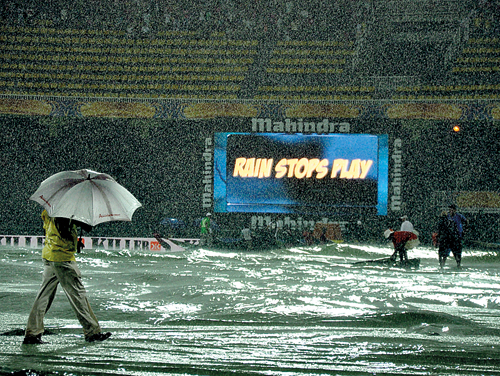Duckworth, Lewis and Senaka
 The World Cup semi-finals between England and South Africa in 1992 became a talking point of the cricket world due to an ‘unfair’ rain related rule that cost South Africa a spot in the finals of the World Cup.
The World Cup semi-finals between England and South Africa in 1992 became a talking point of the cricket world due to an ‘unfair’ rain related rule that cost South Africa a spot in the finals of the World Cup.
South Africa’s task of gathering 22 runs from 13 balls was reduced after a brief spell of rain to 21 runs required off a single delivery in this World Cup semi-final game. The game became a farce and the subject of ridicule and parody.
ICC then requested two British mathematicians Frank Duckworth and Tony Lewis to design a reliable model to be used in rain affected one day cricket matches. Their proposal was accepted and though later somewhat modified by Steve Stern it is now used as the ‘Duckworth-Lewis’ method.
Senaka Weeraratna, a Sri Lankan lawyer, conceived an unique concept called ‘player referral’ as far back as 1997 to minimise on-field umpire errors. His letter to the editor entitled ‘Third umpire should perform the role of an appeal judge’ was first published in the ‘Australian’ (Australia’s national newspaper) on March 25, 1997, and thereafter in several newspapers and journals all over the cricket world.
Until he drew public attention to the benefit of such a player referral system, there was no such system or mechanism in any other sport (Wikipedia.) His concept is undoubtedly revolutionary in its breadth and scope because it challenges the validity of a fundamental rule since the inception of cricket – the decision of the umpire is final.
Basically, the Decision Review System (DRS) is a technology-based process for assisting the match officials with their decision-making. On-field umpires may consult with the third umpire (an Umpire Review) and players may request that the third umpire consider a decision of the on-field umpires (a Player Review).
Under the DRS a player of either side is empowered to appeal directly to the third umpire against the decision of an on-field umpire. It removes the finality of a decision made by an on-field umpire in upholding or dismissing an appeal. This is a revolutionary change. It goes against a cardinal tenet of cricket tradition namely that the umpire’s word is final. Nevertheless, it has brought integrity and justice to the game in place of an over exaggerated, flawed and abused method of adjudication.
In 2006, the International Cricket Committee of the ICC formally adopted the concept of Player Referral conceived by Senaka Weeraratna, and later introduced it to the cricket world as the Umpire Decision Review System (UDRS also called DRS).
The DRS is now used in all formats of the game (Test, ODI and T20) whereas the Duckworth-Lewis method is purely confined to rain affected one day internationals (ODI) and T20 cricket matches. With the improvement in technology the accuracy of DRS is expected to increase further and many a team and players will benefit.
A case in point is the just concluded India vs Sri Lanka T20 series. A Sri Lankan batsman was adjudged caught-behind while attempting to nudge at a delivery coming on his leg side. But when the batsman appealed to the third umpire, the ground umpire’s decision was reversed as ‘Ultra Edge’ clearly showed that there was no bat involved. Sri Lanka had to take only one run to win. The umpire then signalled a wide and Sri Lanka won the match. In the absence of DRS and if it was the last bowl of the game, Sri Lanka would have lost the chance of winning the match.
DRS – great boon to cricket
The DRS has been a great boon to the world of cricket ever since its official introduction to Tests by the ICC in October, 2009. Many a batsman’s innings and sometimes even a cricket career has been salvaged by bringing into play of the DRS, which prevents patently wrong umpire decisions to stand.
It has helped umpires to be more at ease; enabled them to be more confident, contributed towards making the playing environment better. Today the players behave more responsibly and regular on-field outbursts have been greatly reduced. Most importantly it has led to a 7% increase in the accuracy of umpire decision making i.e., from 91% to 98% according to ICC sources. It has served the best interests of cricket given the plaudits coming from all sectors for the DRS.
Shashi Tharoor
Shashi Tharoor, the Indian politician, recently expressed his views on the impact that the Decision Review System (DRS) has had on the modern game, and he stated unequivocally that it has been one of cricket’s best innovations. Tharoor further said that international cricket should never be without DRS in the future, given how many errors the technology prevents.
“DRS is such a major innovation. I never want to see international cricket without DRS ever again. It is so indispensable and eliminates so many bad decisions, and it creates an additional form of excitement for the viewer. It adds an extra element of tension to the plot and it is a very welcome addition as far as I’m concerned,” Shashi Tharoor said.
The world is yet to give full credit to Senaka Weeraratna for this major innovation that has turned the game of cricket on its head. The more important question is whose brainchild i.e., that of Duckworth-Lewis or that of Senaka Weeraratna has served the best interest of the game of cricket.
Though both the Duckworth-Lewis method and the Senaka Weeraratna Rule are clearly meant to enhance accurate decision making it is indisputable that integrity of the game and Justice has been best served by DRS.
Varsha Thakur, the Indian journalist calls Senaka Weeraratna, the ‘Dharmaraja’ of cricket and the father of DRS.
- Rohan Abeygunawardena


